Mini projector purchasing advice: how to choose the right product
- The most important facts in brief
- The portable projectors are particularly suitable as business projectors for lectures and presentations in everyday work.
- Although their compact design makes them suitable for taking to a friend’s house for a movie night, their image brightness and resolution are quite poor. These devices therefore require complete darkness for adequate image quality.
- While LED mini projectors are considered economical perennial favourites, DLP technology impresses with its high-contrast resolution.
- Accessories such as a power bank, a portable speaker or a transport bag complete the equipment.
Mini projectors – the portable presentation artists
Anyone who has ever had the pleasure of using a beamer, either privately or professionally, knows that it is not exactly a lightweight. That’s why the much lighter mini projectors, also called pico projectors or short-distance projectors, are becoming more and more popular. These mobile projectors are ideal for travelling because they fit into any laptop backpack and weigh less than one kilogram. This means that the weight is less than half that of a conventional beamer.
Whereas in the past bulky overhead or slide projectors had to be used for presentations, nowadays compact projectors are used that professionals can keep in their briefcase.
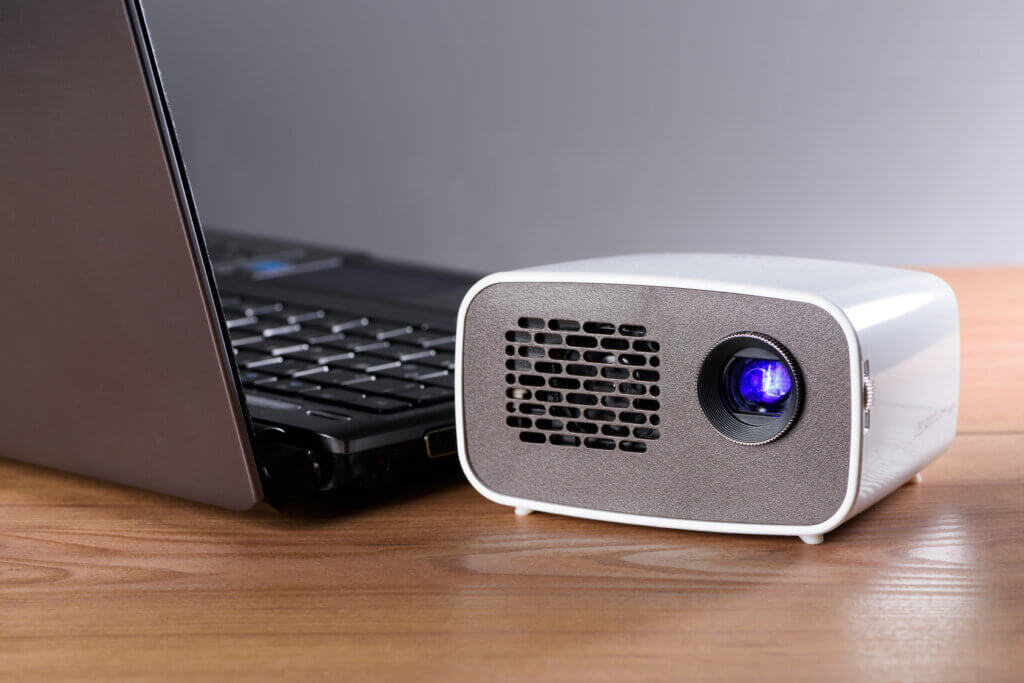
Those who own a portable projector do not have to worry about whether a projector will be available on site for their next PowerPoint presentation. Moreover, the practical device is not only suitable for everyday work: in the evening – at least with high-priced devices – a feature film can be projected onto the wall. But are mini projectors intended more for occasional users or can they keep up with a full HD or home cinema projector?
The pros and cons
Although users of a mini projector have to make some compromises in terms of picture quality due to its size, the portable projectors also have some advantages:
Pros
- Handy and compact
- Suitable for transport
- Perfect for everyday work and DVD evenings
- Long-life LED lamps
- Power supply via rechargeable battery possible
- Numerous connection options for media devices
Cons
- Poor brightness
- No Full HD resolution
- Relatively expensive with good quality
LED or DLP technology?
Mini projectors differ primarily in terms of the type of lamps they use. Manufacturers use either LED or DLP technology. LCD or laser beamers are hardly available on the market in a compact design because the technology is difficult to compress. Most mini projectors are equipped with LED lamps because they are particularly small. However, if you are looking for high quality, you should rather go for the much more expensive DLP technology.
LED mini projectors: the perennial favourites
LED (light-emitting diode) lamps have an exceptionally long life of around 20,000 hours, and neither colour intensity nor sharpness deteriorate over this long period. For this reason, they rarely need to be replaced. Nevertheless, the user should check them regularly.
The low-light mini-LED projectors are hardly contrast-rich in normal light. Their lamps provide less brightness than beamers with LCD or DLP technology and therefore not only consume less electricity but also emit less heat. In addition, the small lamps do not take up as much space in the projector and allow battery operation.
DLP mini projectors: The high-contrast ones
DLP mini projectors provide a particularly sharp, saturated and balanced colour image, projecting a good enough picture onto the wall even in daylight. This technology uses numerous micromirrors – one for each pixel – which rotate about 5,000 times per second and thus send an image signal across the lens.
Because of the high contrast, DLP projectors are also suitable for playing 3D films, but fast movements can sometimes cause rainbow effects, which means that viewers perceive the individual images separately. DLP technology works with three different LEDs, red, green and blue.
What to look for when buying a mini projector
Because of their low power requirements, most mini projectors run on rechargeable batteries, so there is no need for an annoying cable. In contrast to large beamers, their microtechnology makes them rather quiet in operation and comparable to table fans. Here is a summary of the other criteria to look out for before buying:
Brightness

(LED) mini projectors do not score with brightness. As a rule, they have between 100 and 150 lumens, which is roughly the luminosity of a 20-watt bulb. In contrast to the use of a normal projector, which has around 1,000 lumens, the room must be darkened when using a mini projector. In any case, the luminosity should not be less than 100 lumens per square metre so that the image is recognisable. In very dark rooms, for example, it is also worth switching on the eco mode because the lamp will last much longer this way.
Let there be light!
Lumen is the unit of luminous flux that indicates brightness. The higher the lumen value, the better the mini projector can be used in daylight. Suitable values are
- 100 to 250 lumens per square metre are only suitable in well-darkened rooms,
- 250 to 500 lumens per square metre even in slightly darkened rooms and
- more than 500 lumens per square metre even in bright rooms or outdoors.
Resolution

Since mini projectors often have only a small number of pixels, most films look very blurred. Especially the small details are only perceptible in a blurred way. A good beamer should have a resolution of at least 1,280 by 720 pixels. For a mini projector, the values are more like 800 by 480 pixels. The native resolution indicates the number of pixels or the digital resolution of a display device. In the case of the maximum scalable resolution, the beamer converts the image signals of the connected devices up to the full HD resolution of 1,920 by 1,080 pixels to a native resolution, whereby a loss of quality must be expected. To ensure that the small lenses display the image sufficiently sharply, the beamer should not be far from the wall. A higher resolution is also accompanied by a larger projection surface, which varies between two and four metres. There are now even mini projectors in 4k and full HD format.
Image formats and display
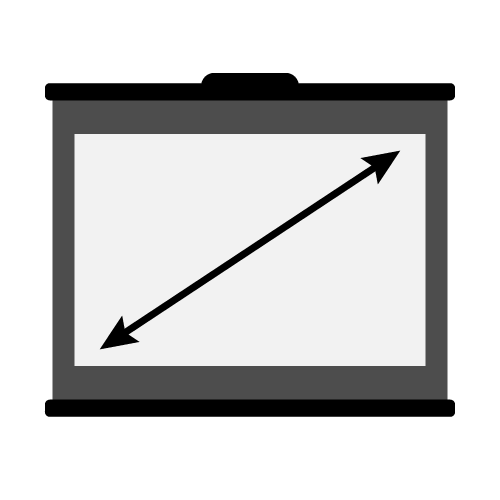
Compared to large projectors, mini projectors are on a technically lower level. Their projection surface is smaller and more reminiscent of the surface of a flat-screen TV. The so-called keystone correction ensures a straight image on the wall. With the help of this correction, the picture becomes rectangular regardless of the angle to the wall. While expensive models correct the image automatically, cheaper models require manual adjustments by moving the mirror inside. However, the possibilities here are severely limited, so that a rectangular picture is only possible from certain positions. Furthermore, the output of a 4:3 format is just as possible as the output of a 16:9 format.
Connection options

With a mini projector, the connection options are very important. For example, a smartphone, USB stick or other storage devices can be connected via a USB port. Ultimately, any device, from a Playstation to a Blu-Ray player, can be connected. For photo presentations, on the other hand, an SD card slot is very practical. Integrated media systems, i.e. internal memory, make it possible to sort photos and videos without a PC and even store them. The majority of all mini projectors can be used autonomously, i.e. without a connection cable. However, an HDMI connection facilitates the transmission of image and sound, as only one cable is needed. Otherwise, users would have to connect speakers or headphones for sound transmission, for which an output is also necessary. Finally, wireless connection is possible via WLAN or Bluetooth, depending on the model.
Operating mode
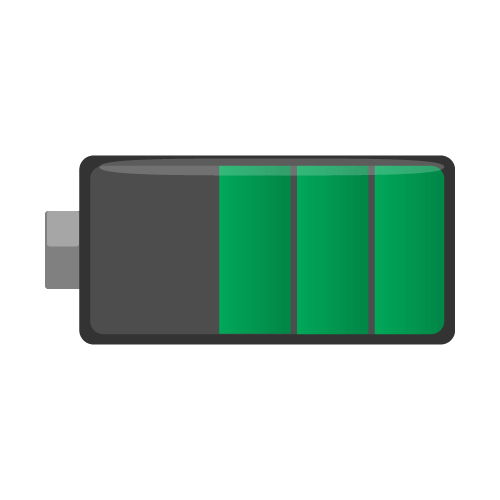
While some models are operated via a fixed power connection, others have an integrated rechargeable battery. Before making a purchase decision, it is important to think about where you intend to use the projector. Battery-operated mini projectors score points not only for their flexibility of use, but also for their light weight, which on average is no more than 120 to 300 grams. With a bright display, however, these devices only last between 90 and 120 minutes. For longer presentations, users prefer to use electrically powered mini projectors. Although these weigh between 600 grams and one kilogram, they are convincing with their uninterrupted performance.
From the power bank to the loudspeaker: the accessories
The accessories of a projector include, for example, a screen, a stand or a remote control. With some models, the buyer also receives a practical transport bag so that he can easily carry the device with him. The bag also protects the projector from dirt and scratches, which greatly increases its longevity. In an emergency, a photo bag is also suitable, for example for a compact camera.
The right cables are important – from the HDMI cable to the USB cable to the charging cable, which should not be missing, especially when travelling. Which other cables are needed depends on the individual needs. The basic cables, such as the power supply unit, are usually already included in the scope of delivery.
If you forget the charging cable every now and then when you are on the road and are annoyed by an empty battery, you should also think about purchasing a so-called power bank, with which users can charge all kinds of devices, be it smartphones or mini projectors. This usually allows a mini projector to be fully charged two or three times, so that the evening can be filled with cinematic entertainment even without a power supply. Ideally, the power bank should have around 8,000 milliampere hours.
Although most mini projectors have integrated speakers, they tend to be undersized due to their compact design. Users who want to use the projector in different places are advised to use a portable speaker that produces louder and more balanced sounds. Depending on the model, the connection is made via Bluetooth or cable. Due to their integrated rechargeable battery, they are also not dependent on a power socket. However, users of a mini projector should pay attention to the manufacturer’s instructions, as some devices can only be upgraded with the accessories of their own brand.
It’s all about the right care!
Before each use, it makes sense to clean the lens so that the image is projected as sharply as possible and free of grease spots or other impurities. A damp microfibre cloth or a compressed air spray is suitable for this purpose, but never an ordinary cloth, as this will cause scratches.
A microfibre cloth can also be used to clean the beamer housing. If the dirt is more severe, a mild, pH-neutral cleaning agent will help. In addition, it is necessary to remove dust from the device regularly.
Who is a mini projector suitable for?
Mini projectors are particularly suitable for working people who would otherwise have to constantly borrow a device, which entails a certain amount of organisation. Teachers also have advantages with a portable projector, as they can easily carry the device in their briefcase when needed. On holiday, for example in a caravan or holiday home, the portable projector also saves one or two rainy evenings by throwing favourite films onto the wall. Small film sessions in the garden can also be realised in the late evening. However, film fans should look for DLP technology. In addition, an external playback device for music is indispensable. Ultimately, the purchase is worthwhile for anyone who places more value on mobility than on picture quality.

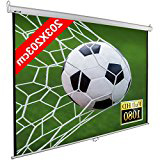
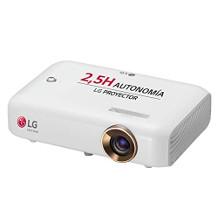
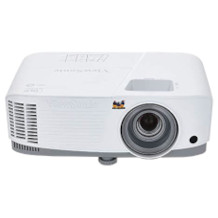
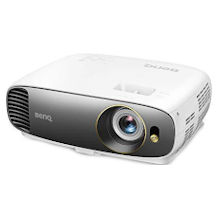
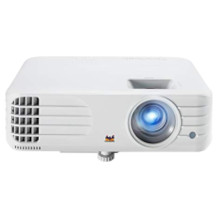
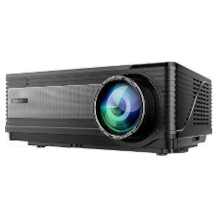

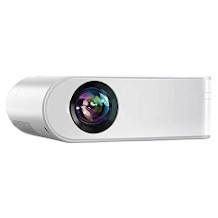
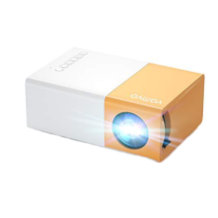
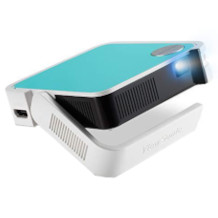
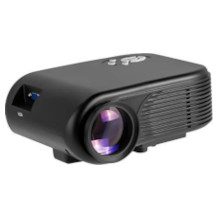
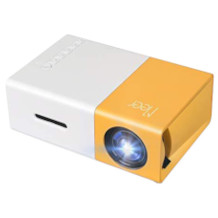
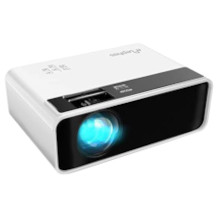

 247 reviews
247 reviews
